Please Report Any Broken Links Or Trouble You Might Come Across To The Webmaster.
Please Take A Moment To Let Us Know So That We Can Correct Any Problems And Make Your Visit As Enjoyable And As Informative As Possible.
| Click On Image For Full Size |
Size | Image Description | Source | |
|---|---|---|---|---|
| 1938 - 1941 / Construction - Shakedown |
||||
 | 422k | Proposed Outboard Profile for U.S. Battleships (BB-55 / 56), 4 May 1937. | National Archives Identifier: 31491079 Photo courtesy of catalog.archives.gov | |
 | 92k | Model of the North Carolina class (BB-55 / 56) without her propulsion system and skegs, 30 May 1937. | Photo from National Archives & Record Administration (NARA), Record Group (RG-19N) Box 33. Courtesy of Dan Treadwell. | |
 | 94k | Model of the North Carolina class (BB-55 / 56) with her propulsion system and skegs, 30 May 1937. | Photo from National Archives & Record Administration (NARA), Record Group (RG-19N) Box 33. Courtesy of Dan Treadwell. | |
 | 170k | Rush plans for new U.S. Battleships. Washington, D.C., 23 June 1937. Scene in Construction and Repair Division of the U.S. Navy Department where plans for the two new 35,000 ton battleships are being rushed to completion. Work on the ships will get underway in four to six months, Charles Edison, Assistant Secretary of the Navy, announced. One will be built at the Brooklyn Navy Yard and the other at Philadelphia. | Photo # LC-DIG-hec-22916 & text courtesy of the Harris & Ewing Collection. | |
 |
NR | DREADNAUGHT RETAINS SUPREMACY AS NAVAL WEAPON Keels Soon Will Be Laid for Battleships North Carolina (BB-55) and Washington (BB-56)—United States and Other Navies Still Regard the Costly Battleship as Most Impregnable Fighting Unit, Aircraft Notwithstanding. |
Image and text provided by Library of Congress, Washington, DC. Photo from Evening Star.[volume] (Washington, D.C.) 1854-1972, 24 July 1937, Image 15, via chroniclingamerica.loc.gov. | |
 | NR | Navy Yard Prepares for Making of 16-Inch Battleship Guns | Image and text provided by Library of Congress, Washington, DC. Photo by Evening Star. [volume] (Washington, D.C.) 1854-1972, 19 August 1937, Image 23, courtesy of chroniclingamerica.loc.gov. | |
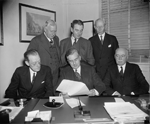 | 145k | New battleship design board. Washington, D.C., 8 October 1937. A special advisory board on battleship plans, which was recently named by Secretary of the Navy Swanson, held their initial meeting at the Navy Department today. The board will be charged with obtaining for the Navy Department the advice of outstanding experts in the principal fields of Naval construction to use in completing the designs of the two new battleships of the North Carolina class (BB-55 / 56). In the photograph, left to right, (sitting): W.F. Gibbs, President of Gibbs and Cox, Inc.; Assistant Secretary of the Navy Charles Edison; and Admiral Joseph Strauss, U.S.N. Standing, left to right: John F. Metton, President, N.Y. Shipbuilding Corp.; Joseph W. Powell, United Shipyards Inc.; and Professor William Hovgaard, Massachusetts Institute of Technology. | Photo # LC-DIG-hec-23466 photo & text courtesy of the Harris & Ewing Collection. | |
 | 476k | 17 Photo PDF of the turret mock up of the North Carolina class battleships. | NARA (National Archives Record Administration) photo courtesy of Scott Koen & ussnewyork.com. | |
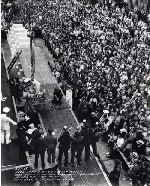 |
112k | After months of preparation, the first step in the actual construction is reached as the keel is laid 14 June 1938 by a high Navy official (Rear Admiral Luther E. Gregory C.E.C. USN Ret.), and work upon the shipways begins. Thousands of men will work out on the shipways, while thousands of others in the shops and offices will helps them fulfill their tasks. | USN photo & text courtesy of usswashington.101525com & submitted by Mike Green. | |
 015656k | NR | Keel Is Laid for New U. S. Warship The scene as the first rivet was driven for the laying of the keel of the navy's newest battleship, the $65,000,000 dreadnaught Washington (BB-56), at the Philadelphia navy yard. Left to right: Mayor S. Davis Wilson of Philadelphia; Rear Admiral Wat Cluverius, commandant of the Philadelphia navy yard; Lieut. Comdr. William Cunningham, representing Gov. George Earle of Pennsylvania; Rear Admiral Luther Gregory, civil engineer corps, (retired), representing Governor Martin of Washington; Capt. Alexander Hamilton Van Keuren of the civil engineer corps, in charge of construction at the navy yard; and J. C. Kauffman, master sheet metal worker at the navy yard. | Image and text provided by Washington State Library; Olympia, WA. Photo from Coulee City Dispatch. (Coulee City, Wash.) 19??-19??, 30 June 1938, Image 3, courtesy of chroniclingamerica.loc.gov. | |
 |
136k | Commemorative postal cover marking the keel laying of the Washington (BB-56), 14 June 1938. | Photo courtesy of Tommy Trampp. | |
 | 184k | Navy opens bids for battle wagons. Washington, D.C., 2 November 1938. The Navy opened bids today on construction of three 35,000 ton battleships today, all bids specified that the dreadnaughts be completed within 52 months. The guns, armor plate, and other accessories to be furnished by the Government cost an estimated 15,000,000 dollars per ship. The ships are the first of that size to be built in 15 years. Seated, left. Admiral William Leahy, Chief of Naval Operations, and Sec. of the Navy Claude Swanson, right. Standing - left- Rear Admiral William G. Du Bose, Chief of the Bureau of Construction and Repair and right- Rear Admiral Charles Conard, Chief of the Bureau of Supplies and Accounts. | Photo # LC-DIG-hec-25307 & text courtesy of the Harris & Ewing Collection. | |
 015551 | NR | BATTLESHIP MODELS TESTED In the Washington Navy Yard towing basin models of proposed 45,000-ton battleships, which would be the world's mightiest warships, now are being tested. The development is being conducted secretly and photographs of the models are forbidden. W. H. Gotthardt is shown inspecting another type of hull between runs of the 45,000-ton ships, which are towed by the same carriage. | A .P. photo Image and text provided by Library of Congress, Washington, DC. Photo from Evening Star.[volume] (Washington, D.C.) 1854-1972, 10 November 1938, Image 50, courtesy of chroniclingamerica.loc.gov. | |
 014436 |
NR | Comparing Proposed Supership and Biggest Warboat President Roosevelt is studying a recommendation calling for construction of one of the largest and most powerful superdreadnaughts ever launched. Photos above, reduced to scale, show how the 710-foot warship (North Carolina class) would compare with the 624-foot California (BB-44), now the largest battleship in U. S.fleet. Both pictures are of the California. The new 45,000-ton dreadnaught would cost around a hundred million dollars. |
Image and text provided by University of North Carolina at Chapel Hill Library, Chapel Hill, NC. Photo from The Times-News. [volume] (Hendersonville, N.C.) 1927-current, 19 December 1938, Image 6, via chroniclingamerica.loc.gov. | |
 |
188k | The Washington (BB-56) is seen on 6 January 1939 at the Philadelphia Navy Yard. The progress on the double and triple bottoms can be seen and the bulkheads for machinery space No. 2 have been erected. Framing for the tunnel of the twin skeg stern is also visible. | USN photo courtesy of Mike Green from "Iowa Class Battleships-Their Design, Weapons & Equipment" by Robert Sumrall. | |
 | 1.50k | Outboard profile, General Arangement Plan # 216402 for Battleships of the North Carolina Class (BB-55 / 56), dated 26 September 1939. | USN photo courtesy of Pieter Bakels. | |
 |
307k | Washington (BB-56) under construction at the Philadelphia Naval Ship Yard. | USN photo. | |
 |
465k | Washington (BB-56) at the Philadelphia Navy Yard, on 15 May 1940 being made for launching. The ship will be launched on 1 June. | Photo courtesy of the George D. McDowell Philadelphia Evening Bulletin Photographs @ digital.library.temple.edu via Mike Green. | |
 015685f | NR | Young Sponsor of
New Battleship When the 35,000-ton Washington (BB-56) slides down the ways at Philadelphia Navy Yard on 1 June, it will he christened by 15-year-old Virginia Marshall, above of Spokane, Wash., great great granddaughter of Chief Justice Marshall. The Washington, first battleship to be launched since 1921, will be the most powerful ship in the American fleet. |
Image and text provided by Connecticut State Library, Hartford, CT. Photo from The Waterbury Democrat. [volume] (Waterbury, Conn.) 1917-1946, 17 May 1940, Image 13, courtesy of chroniclingamerica.loc.gov. | |
 |
43k | Invitation to the Launching of the Washington (BB-56), 1 June 1940. | USN photo courtesy of Robert M. Cieri. | |
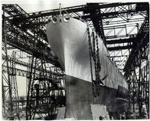 |
208k | Getting ready for launching, her bow area not dressed yet with festive bunting. | A. P. wire photo courtesy of San Francisco Examiner via David S. Smith. | |
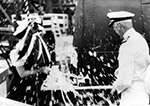 | 990k | Washington (BB-56) christening by Miss Virginia Marshall, great-great-great granddaughter of John Marshall, 4th Chief Justice of the United States. | Photograph courtesy of Dale Hargrave. | |
 |
80k | The begining of the launching ceremony for the first battleship built in the U.S. in almost twenty years, crowds gather around the Washington (BB-56) at the Philadelphia Naval Ship Yard on 1 June 1940. She is the 1st battleship built and launched by the USN since West Virginia (BB-48) in November 1921. | USN photo. | |
 |
1.60k | Ready to start her slide down the ways. | Photograph courtesy of Dale Hargrave. | |
 |
113k | Christened and sponsored by a charming lady, she slides down the ways into the Delaware River, and the second stage is completed. | USN photo & text courtesy of usswashington.com & submitted by Mike Green. | |
 |
219k | Waterborne is Washington (BB-56). | A. P. wire photo courtesy of San Francisco Examiner via David S. Smith. | |
 |
1.33k | Washington (BB-56) being assisted by tugs after her launching. | Department of the Navy. Bureau of Aeronautics. Naval Aircraft Factory, Philadelphia, Pennsylvania. Image from the National Archives and Records Administration. Still Picture Records Section, Special Media Archives Services Division. ARC Identifier 518859, courtesy of Robert Hurst. |
|
 |
422k | "Quick dip, then back in dock" "The battleship Washington (BB-56), its launching pennants still waving gaily in the breeze, is pushed into Navy Yard dock for completion. It slid from the ways a short distance down the Delaware River." Note: This photo is shown horizontally backwards; note printing. |
Photo i.d. via John Chiquoine. Photo courtesy of the George D. McDowell Philadelphia Evening Bulletin Photographs @ digital.library.temple.edu | |
 |
126k | Commemorative postal cover marking the launching of the Washington (BB-56), 1 June 1940. | USN photo courtesy of Robert M. Cieri. | |
 015680 | 689k | The president views the ship and its workers. Pierside construction continues after launch of Washington (BB-56) at Phila Naval Shipyard, with a visit on 20 September 1940 from government figures. Among the figures seated in the car are (in no order) FDR, Senator Joseph F. Guffey (D. Penna), Rear Admiral A.E. Watson, Commandant of the Fourth Naval District in Philadelphia, and Pennsylvania secretary of revenue John B. Kelly. | Photo P340167 via digital.library.temple.edu courtesy of Temple Digital Archives, McDowell Collection via John Chiquoine. | |
 |
569k | "Pouring propeller for battleship Washington (BB-56) at Navy Yard", 13 October 1940. | Photo courtesy of the George D. McDowell Philadelphia Evening Bulletin Photographs @ digital.library.temple.edu | |
 015662a | NR | Casting Propeller for U.S. Dreadnought In an inferno-like scene of smoke and steam, 60,000 pounds of molten manganese bronze is poured into a mold to form the first of four propellers for the 45,000-ton battleship Washington (BB-56), being built at the Philadelphia Navy Yard. The propeller will weigh 35,000 pounds when completed, the other 25,000 pounds being lost in trimming and polishing. | Image and text provided by University of North Carolina at Chapel Hill Library, Chapel Hill, NC. Photo from Henderson Daily Dispatch. (Henderson, N.C.) 1914-1995, 14 October 1940, Image 1, courtesy of chroniclingamerica.loc.gov. | |
 015556c | NR | Captains of New Battleships Born to Traditions of Sea CAPT. HOWARD H.J. BENSON & CAPT. OLAF M. HUSTVEDT. | Image and text provided by Library of Congress, Washington, DC. Photo from Evening Star.[volume] (Washington, D.C.) 1854-1972, 11 April 1941, Image 35, courtesy of chroniclingamerica.loc.gov. | |
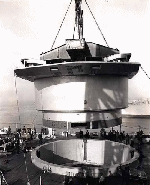 |
72k | Finally, a tremendous turret, machined from start in the Turret Shop and carried to the ship by barge, is swung into place. | USN photo & text courtesy of usswashington.com & submitted by Mike Green. | |
 |
157k | Who looking at who doing what? Officers and crew line the deck of the uncommissioned Washington (BB-56) while the overhead crane plies her business, 3 May 1941. | A. P. wire photo courtesy of San Francisco Examiner via David S. Smith. | |
 |
66k | The mighty warship, now virtually completed, goes into drydock for fitting-out, where last-minutes adjustments and improvements are made. | USN photo & text courtesy of usswashington.com & submitted by Mike Green. | |
 |
72k | The Washington (BB-56) (with a British battleship in the background), is seen here in a pre-commissioning photo at Philadelphia Navy Yard and illustrates the design for the North Carolina class (BB-55 / 56). The ship has not been fitted with main battery directors or with 1.1-inch machine guns. Note, too, that the after main battery director station has not yet been braced against vibration. | Photo & text courtesy of Mike Green & U.S. Battleships: An Illustrated Design History by Norman Friedman. | |
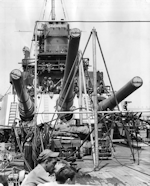 |
233k | "Commissioning Day near for the Washington (BB-56) "Its big guns in place and much of its machinery installed, Navy's new 35,000-ton battle wagon nears completion at Navy Yard here, several months ahead of schedule. After commissioning on May 15th, six weeks will be required for final adjustments." |
George D. McDowell Philadelphia Evening Bulletin Photographs @ digital.library.temple.edu. | |
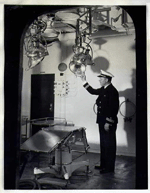 |
123k | 3 May 1941: JUST IN CASE; With 15 May set as commissioning day the giant Washington's (BB-56), 35,000 ton battleship nears completion at the Philadelphia Navy Yard. Already finished and open for business, which we hope it won't get, is the Operating Room of the ship's hospital. | A. P. Wire Photo courtesy of San Francisco Examiner via David S. Smith & Tommy Trampp. | |
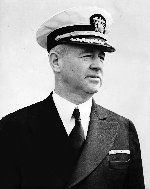 |
601k | Philadelphia Navy Yard (3 May 1941) - Capt Howard Hartwell James Benson, of Baltimore, Maryland, son of the late Admiral Benson, who will be in command of the new battleship Washington (BB-56), shown at the Philadelphia Navy Yard today where he inspects the mighty ship which will be commissioned on May 15th. The new battleship is rated at 35,000 tons and will join the fleet this year. | Photo & text courtesy of Bill Gonyo. | |
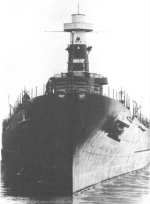 |
74k | Undated bow view of the Washington (BB-56) fitting out at the Philadelphia Navy Yard prior to her 15 May 1941 commissioning. | USN photo courtesy of Mike Green. | |
 |
94k | Undated photo of the Washington (BB-56) at Philadelphia Navy Yard. The ship has been commissioned as evidenced by the Union Jack at her bow, but has not yet been fitted with light weight A.A armament, fire control directors, or search radars. The date of this photo may be her commissioning day, 15 May 1941, as the flag at the main mast is either that of the Secretary of the Navy or the Under Secretary of the Navy. The only difference in these two flags is the color, which is impossible to tell in this B/W photo. | Contributed by Mike Green / USN photo. | |
 015638c | 1.37k | NAVY TARS HEAR SECRETARY'S MESSAGE - Standing under the aft guns of the battleship Washington (BB-56) at her commissioning today, officers and men of the crew heard Navy Secretary Frank Knox declare: "It is a marvelous thing to be called to duty on one of the two greatest battleships plying the ocean, both of them flying the flag of the United States." | Photo by Hulton Archive/Getty Images, courtesy of gettyimages.com. | |
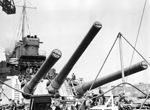 015633 | 640k | Construction workers enjoy a lunch break aboard the Washington (BB-56), 1941. | Photo courtesy of the George D. McDowell Philadelphia Evening Bulletin Photographs @ digital.library.temple.edu | |
 |
659k | "Mightiest ship afloat joins the U.S. Navy" "Scene aboard the 35,000-ton battleship Washington (BB-56) during commissioning exercising at the Navy Yard this afternoon." |
Photo courtesy of the George D. McDowell Philadelphia Evening Bulletin Photographs @ digital.library.temple.edu | |
 |
67k | Port Bow, off the Philadelphia Navy Yard, Pennsylvania, 29 May 1941. She is painted in the Measure 1 camouflage scheme. | National Archives # 19-N-24147 | |
 |
221k | Departing Philadelphia Navy Yard for her shakedown cruise, 29 May 1941. | Contributed by Joseph M. Radigan (of blessed memory) / USN photo. | |
 |
167k | Looking aft from the bow of Washington (BB-56) while refueling from Salamonie (AO-26). This photo and the folowing were taken prior to the installation of the 20MM guns, which would put them in the Atlantic prior to April of '42, but after the MS-12 mod camo was applied around November/December of '41. Note that the MK.37 director still has to be installed on the oiler! |
Photo I.d. & text courtesy of Richard M. Jensen. USN photo courtesy of Pieter Bakels. | |
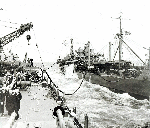 |
174k | Looking forward from the stern area of Washington (BB-56) while refueling from Salamonie (AO-26). Notice the starboard boat crane being used to secure the oil hoses and the forward 5"/38 twin mounts with their barrels pointing at an elevated angle during this refueling. |
Photo I.d. & text courtesy of Richard M. Jensen. USN photo courtesy of Mike Green. | |
| January - August 1942 / War in the Atlantic |
||||
 |
750k | Undated photo of the Washington (BB-56) receiving supplies while underway, from an unidentified ship. | Source: United States National Archives, Photo No. ARC 512915. USN photo courtesy of Mike Green. | |
 | 2.55k | Official caption reads: "Wasp (CV-7) anchored at Scapa Flow about June 1942. Note: Battleships North Carolina (BB-55) and Washington (BB-56) in upper right." Date and location of this photo and the two below, however, are wrong: Rick E. Davis correctly states: "Wasp, North Carolina, Washington, and an unidentified destroyer are seen at anchor in Casco Bay, ME, on 25 March 1942." "From the Deck Logs for Wasp, North Carolina and Washington, Wasp and Washington operated together often in early 1942, however these two were never at the same location with North Carolina except in March 1942 at Casco Bay, ME. Wasp arrived at Casco Bay late on 24 March 1942 with her cruiser and destroyer escorts. She departed with Washington and the other ships that made up TF 39 headed for the UK to be part of the Home Fleet early on 26 March 1942. So the only day that these photos could have been taken was on 25 March 1942." | Official U.S. Navy Photograph, now in the collections of the National Archives and Records Administration (NARA), photo # 80-G-K-451 courtesy of Rick E. Davis via Fabio Pena. | |
 |
97k | 1942 photo of an unidentified escorting destroyer, as seen from the Washington (BB-56) port main deck. 5"/38 twin mounts and manned 20mm light A.A. guns are visible. | USN photo courtesy of Mike Green. | |
 |
61k | Washington (BB-56) at Hvalfjord, Iceland in early 1942. | USN photo | |
 |
684k | Washington (BB-56), at Hvalfjord, Iceland in early 1942. Inset a drawing by Dwight Shepler of Glenn Davis, Washington's popular skipper. | USN photo courtesy of Pieter Bakels. | |
 |
499k | Washington (BB-56), and HMS King George V at sea in convoy escort duty in April, 1942. | USN photo courtesy The Battleships by Ian Johnston & Rob McAuley, submitted by Mike Green. | |
 |
890k | Spring, 1942 photo showing the Washington (BB-56), flagship of TF 39 in the Atlantic Ocean with spray over the bow, as seen from the port side of the bridge structure. The ship was serving with the Royal Navy at that time. Clearly visible is the third anchor storage notch in the port bow, known as the ‘billboard'. All of the six North Carolina/South Dakota class ships were designed with a 3rd anchor location on their main deck. The anchors were to be bolted onto the ship's hull, with no anchor chain connected to them. It appears that the Indiana (BB-58) and the Alabama (BB-60) had these plated over when they were being fitted out. Photos of the other four ships, North Carolina (BB-55), Washington, South Dakota (BB-57), and Massachusetts (BB-59), show the 'notch' early in their careers. This location was later covered by 20mm/40mm mount locations, as seen in late 1944 North Carolina and Massachusetts photos and were eventually removed completely, during refits or in the case of Washington when her bow was replaced in April, 1944. | Source: US Navy and Marine Corps Museum/Naval Aviation Museum, Photo No.1999.324.001 courtesy of Mike Green. | |
 |
538k | 4 photo PDF featuring - Bow view of Washington (BB-56) anchored at Hvalfjord, Iceland in April, 1942. Other views are: underway in the mid-Atlantic Ocean in April, 1942, as seen from the HMS Edinburgh, & anchored at Hvalfjord, Iceland, as seen from HMS Victorious in April, 1942. | Source: Imperial War Museum Admiralty Official collection by Ware, C.J. (Lt),& Coote R.G.G. (Lt) & Parnell C.H., Photo Nos. IWM (A 8952), (A 9240), (A 9239) & (A 9312) © courtesy of Mike Green. | |
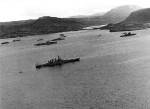 |
126k | Washington (BB-56), HMS Victorious, HMS King George V and an unidentified British heavy cruiser are seen at anchor at Iceland in April, 1942. | USN photo courtesy The Battleships by Ian Johnston & Rob McAuley, submitted by Mike Green. | |
 |
74k | Washington (BB-56) and HMS Victorious, as seen from the aft main turret of HMS King George V. | USN photo courtesy of Mike Green. | |
 |
465k | The battleship Washington (BB-56) at anchor at Scapa Flow, Scotland on 4 April 1942, as seen from the flight deck of the aircraft carrier Wasp (CV-7). Note barrage balloons overhead. | Photo # 1967.038.031 courtesy of US Navy and Marine Corps museum, via Mike Green. | |
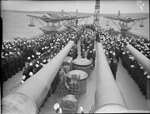 |
528k | The ship's company of the US battleship Washington (BB-56) give three cheers as HMS King George V passes their ship at Scapa Flow. Note the three Vought-Sikorsky OS2U Kingfisher aircraft on their catapults at the stern of the ship, the barrels of three of the battleship's 16 inch guns can be seen in the foreground. | Photo taken by Lt C.J. Ware, Royal Navy official photographer. Photo No. A 8764 from the collections of the Imperial War Museums. Part of the Admiralty Official Collection via Robert Hurst. | |
 |
506k | On the flight deck of HMS Victorious (R 38) a Fairey Albacore is ranged for anti-submarine patrol, with two Fairey Fulmars in front. Astern are Washington (BB-56) and Wichita (CA-45) on convoy duty in the North Atlantic. | Source: Imperial War Museum Imperial Official collection by Parnall, C.H. (Lt), Photo No.IWM (A 9476) © courtesy of Mike Green. | |
 |
427k | Washington (BB-56) and Wichita (CA-45) underway in May, 1942 during Naval cooperation duties with the United States and Great Britain in convoy protection. | Source: Imperial War Museum Admiralty Official collection by Parnall, C.H. (Lt), Photo No.IWM (A 9488) © courtesy of Mike Green. | |
 |
580k | A homeward bound US Freighter passing HMS Duke of York and Washington (BB-56) in May, 1942 off Hvalfjord, Iceland. | Source: Imperial War Museum Admiralty Official Collection by Ware C.J. (Lt), Photo No.IWM (A 8962) © courtesy of Mike Green. | |
 |
2.00k | The covering forces of the PQ-17 Convoy (British and American ships) at anchor in the harbor at Hvalfjord, Iceland, May-June 1942. Washington (BB-56) in foreground loading supplies with HMS Norfolk in the rear. Wichita (CA-45) is in the middle. | USN photo # 80-G-24826 from the National Museum of the U.S. Navy, courtesy of flickr.com. | |
 |
94k | HMS King George V in the lead followed by Washington (BB-56) during convoy escort duty 16 May 1942. | USN photograph from the Author's Collection. | |
 |
1.97k | PDF of German reconnaissance photo of Scapa Flow taken 31 May 1942. | Photo courtesy of Thomas Becher. | |
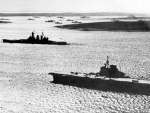 |
70k | June 1942 photo of the ship, in the Atlantic, while on duty with the British Fleet. Anchored at ScapaFlow with the British aircraft carrier HMS Victorious. | USN photo. | |
 |
1.59k | His Majesty King George VI arrives aboard Washington (BB-56) for inspection, 7 June 1942. His Majesty's Flag is flying from the mainmast. | USN photo # 80-G-24795 from the National Museum of the U.S. Navy, courtesy of flickr.com. | |
 |
2.39k | His Majesty King George VI arrives aboard Washington (BB-56) for inspection, 7 June 1942. Captain Benson explains a few things about the galley to the King while Admiral Harold Stark observes. | USN photo # 80-G-24805 from the National Museum of the U.S. Navy, courtesy of flickr.com. | |
 |
668k | HM King George VI accompanied by Admiral Harold Stark are shown inspecting ship's company aboard Washington (BB-56) on 7 June 1942 at Scapa Flow Fleet Anchorage. | Source: Imperial War Museum Admiralty Official Collection by Ware C.J. (Lt), Photo No.IWM (A 8744) © courtesy of Mike Green. | |
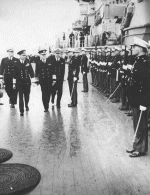 |
47k | Britain's King George VI inspects the Marine detachment of Washington (BB-56), on 7 June 1942. From left are: RAdm Robert C. Giffen, commanding TF 39; King George; Adm Harold R. Stark, special naval observer; and Capt Howard H. Benson, commander of the Washington. Commanding the Marine Detachment is Capt James D. Hittle, who retired as a brigadier general; commanding the 1st Platoon is 1stLt Jonas M. Platt, who retired as a major general; commanding the 2d Platoon is 2dLt Robert Knox. | Photo from Marines in World War II Commemorative Series, A DIFFERENT WAR: Marines in Europe and North Africa by Lieutenant Colonel Harry W. Edwards, U.S. Marine Corps (Retired), courtesy of The Admiralty, London & nps.gov. |
|
 |
35k | Oil on canvas painting by the artist Anthony Saunders, entitled "Arctic guardian - Washington". In the Spring of 1942, Washington (BB-56) was the first of America's fast battleship fleet to participate in combat operations when she was briefly assigned to the Royal Navy. On the 28th June 1942, together with HMS Duke of York, HMS Victorious and an accompanying cruiser and destroyer force, she formed part of the distant covering force to convoy PQ-17 bound for Russia. |
Text and drawing courtesy of naval-art.com | |
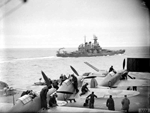 |
486k | Washington (BB-56) as seen from HMS Victorious at sea in July, 1942 in convoy protection duty. Sea-Hurricanes are being refueled on the Victorious. | Source: Imperial War Museum Admiralty Official collection by Parnall, C.H. (Lt), Photo No. © IWM (A 10663) © courtesy of Mike Green. | |
 |
172k | Change of command ceremony for incoming Captain Glenn B. Davis on 25 July 1942 while dry docked at Brooklyn Navy Yard. | Photo ID and text courtesy of Richard Averitt. USN photo courtesy of Mike Green. |
|
 |
170k | Washington's (BB-56) crew assembled on the bow of the ship for change of command ceremony for incoming Captain Glenn B. Davis on 25 July 1942 while dry docked at Brooklyn Navy Yard. | Photo ID and text courtesy of Richard Averitt. USN photo courtesy of Mike Green. |
|
 |
96k | August, 1942 photo just before leaving the East coast for the Pacific. A Kingfisher seaplane is visible at the stern, getting ready to be hoisted aboard. | Photograph Naval History and Heritage Command # 19-N-33803 from the Bureau of Ships Collection in the U.S. National Archives. | |
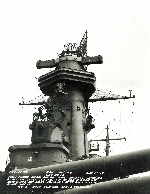 |
176k | Detail shot of the tower foremast taken 18 August 1942 at New York Navy Yard just prior to her transfer to the Pacific. Of notable interest is the location of the surface search radar SG unit on the forward face of the tower. This location caused problems during the upcoming battle off Guadalcanal as it left an arc of 80 degrees that was blind to radar search. During the battle, the South Dakota (BB-57) was in this blind area and valuable time was lost ensuring that the target that was being tracked was the Japanese battleship Kirishima and not the South Dakota. When the Japanese illuminated the South Dakota with searchlights, the picture immediately cleared and the Kirishima was reduced to a wreck by the Washington's main and secondary armament. |
USN photo courtesy of Mike Green. | |
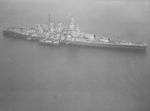 |
2.85k | Washington (BB-56) at anchor, August 1942. | USN photo from the U.S. National Archives and Records Administration BS 33802, courtesy of Robert Hurst. | |
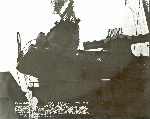 |
89k | Photo taken 18 August 1942 at New York Navy Yard just prior to her transfer to the Pacific. View taken from main deck on starboard looking inboard and upward showing new 20mm gun & ready service chest locker located on 3rd level above superstructure. | USN photo courtesy of Pieter Bakels & Mike Green. | |
 |
1.22k | 18 August 1942 at New York Navy Yard. View taken from above 3rd level above superstructure looking aft showing 1.1" & other useful tools for staying alive in a bad neighborhood. | USN photo courtesy of David Buell. | |
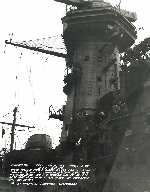 |
294k | View taken from main deck (starboard) forward looking upward and aft to show platform for new experimental gun director MK II on 1.1" Machine gun platform forward of present 1.1" director. Details of tower foremast are visible, most notably the forward facing SG surface search radar. This location caused problems during the upcoming battle off Guadalcanal as it left an arc of 80 degrees that was blind to radar search. | USN photo courtesy of Mike Green. | |
 |
494k | Washington (BB-56) dated 21 August 1942, taken out of NAS NYNY, but listed as BuShips #33801.
NYNY number is #732, and the reverse side is annotated that it was taken at an altitude of 200-400'.
Note the OS2U in the water, the rafts strewn about on the fantail, and the lighters alongside. This was the rig that she was in at Guadalcanal when she took on Kirishima. Also you can see the 'billboard' on the port bow area. It was a storage area for the 3rd anchor. This was removed during wartime refits/rebuilds and was gone on all of the ships by the end of the war. |
Photo courtesy of David Buell. Text i.d. courtesy of David Buell & Mike Green. |
|
 015672 | 1.24k | Getting some last minute shopping done on Washington (BB-56) off New York City, 21 August 1942. | Photo 19-N-33800 courtesy of history.navy.mil | |
| September - December 1942 / Guadalcanal & Fourth Battle of Savo / Island |
||||
 |
63k | Undated port side forward broadside view of the Washington (BB-56) at anchor, protected by an anti-torpedo net. Electronics and light A.A. armament equipment narrow this photo time frame from September, 1942 to the summer, 1943. The notch in the main deck forward is for extra anchor storage and was known as the 'billboard". | USN photo courtesy of Mike Green. | |
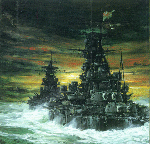 |
55k | Kirishima and sister Hiei trailing on 13 November 1942: The First Naval Battle of Guadalcanal. | Photo courtesy of Pieter Bakels. | |
 |
154k | Photo taken during the battle off Savo Island showing the Washington (BB-56) firing upon the Kirishima on 14-15 November 1942. The low elevation of the barrels shows how the close range of the adversaries; only 8,400 yards, point blank range for the 16"/45 caliber main armament of the Washington. | USN photo courtesy of Pieter Bakels. | |
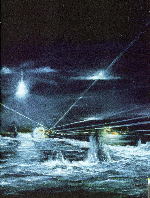 |
890k | The battleship Washington (BB-56) leading South Dakota (BB-57) while firing at Kirishima on the night of 14-15 November 1942. | Photo courtesy of Pieter Bakels. | |
 |
902k | The Japanese battleship Kirishima takes hit after hit from Washington (BB-56) as the battle reaches its climax. | Photo courtesy of Pieter Bakels. | |
 |
87k | Undated bow photo of the Washington (BB-56) firing 5" gun mounts to starboard. This is a very similar appearing photo to the one of the ship firing on the Kirishima on the night of 14-15 November 1942, but in this photo the main turrets are trained forward. Visible at deck level are the side railing and the covered 20mm mounts abreast #2 Main turret. The starboard side of the forward turrets, tower foremast, sky control platform, bridge structure, #1 quad 1.1 machine cannon tub and the Sky 3 secondary gun director are also illuminated in the flash. | USN photo courtesy of Mike Green. | |
 |
170k | The battleship Washington (BB-56) in the lead with the South Dakota (BB-57) trailing in the Night battle of Guadalcanal (14-15 November 1942) from a painting by Lt. Dwight Shepler, USNR. | Courtesy of Pieter Bakels. | |
 |
415k | A painting by the artist Wayne Scarpaci entitled "Night Action". The drawing depicts the Washington (BB-56) in action against the Kirishima at the 4th battle of Savo Island, 15 November 1942. | Drawing courtesy of artbywayne.com | |
 |
109k | Rear Admiral Willis A. Lee, Jr., USN, Halftone reproduction of a photograph taken on board Washington (BB-56), circa 1942-43. | U.S. Naval Historical Center Photograph # NH 48283. | |
 |
5m | PDF Action report of the Battleship Night Action between the U.S. and Japanese forces off Savo Island on November 14-15, 1942.
The following text by Pieter Bakels is a summation of the battle. At 2300 exactly on the night of 14-15 November 1942, the "SG" surface search radar of the battleship Washington (BB-56), following the destroyers Walke (DD-416), Benham (DD-397), Preston (DD-377) and Gwin (DD-433) with another battleship astern, the new South Dakota, began tracking a target, bearing 340T, broad on the starboard bow, distant eighteen thousand yards. The main battery Directors of Washington trained towards the larger of two targets, the Japanese cruiser Sendai under the command of Rear Admiral Hashimoto. Within seconds the rangekeeper had a firing solution and Washington's three Main Battery turrets swung to starboard, guns elevated for a range of eleven thousands yards. "Commence Firing!" was ordered at 2317 and "all hell broke loose", as Washington blasted a nine–gun salvo at Sendai, Hunter Cronin in Secondary Conn, ("Battle 2") wrote. Shikinami, the second target was taken under fire by the battleship's starboard Secondary Battery directed by "Sky 3". One minute later, South Dakota rained down shells on the destroyer Shikinami. Aboard South Dakota, William P. Gray was assigned to Main Battery Fire Control Maintenance and Operations. His battle station was Main battery Director #1 as Director Captain/Pointer. He wrote in his memoirs: "The first Main battery action, Savo Island, first sighting of enemy warships. We were ordered to pick out the biggest and commence firing. The closing of Main Battery. Firing key against enemy warships for the first time. Shells on the way and Spotting Officer calling: "No change! No change!" Her bridge and spotting personnel saw Shikinami roll over and sink according to the Action Report. However, Sendai and Shikinami retired in a loop behind a smoke screen, disappearing from view and radar in the closely confined waters of "Ironbottom Sound". When the two Japanese ships retreated behind their smoke screens, the destroyers Walke, Benham, Preston and Gwin opened fire on them and on blobs of light, coming from the direction of the shoreline of Savo Island. The Japanese had not emplaced batteries on Savo but the fire was coming from the destroyers Ayanami and Uranami, sent west around Savo; within their wake the cruiser Nagara (Rear Admiral Kimura) and the destroyers Teruzuki, Inazuma, Shirayuki and Hatsuyuki. The duel was short, ferocious and uneven. Unskilled in night fighting and saving their torpedoes for bigger stuff, the US destroyers opened up with their guns, Gwin firing starshell to illuminate the scene. Japanese spotters used their gun flashes as fine aiming points. The destroyers Ayanami and Uranami each fired a torpedo spread at Gwin but none hit. However at 2330 Walke, the lead ship, began taking hits from 5- and 5.5-inch and fell off to port and took a torpedo eight minutes later in her starboard side, blowing off the forward part of the ship. "Abandon Ship" was ordered at 2345. Depth charges rolling off their tracks and exploding, killed its Captain and many of her hands as they cleared the ship. The enemy cruisers rained down explosives on Benham, Preston and Gwin and a salvo from Nagara reduced Preston to a wreck and on 2336 she too had to be abandoned with 116 killed. Then Gwin got hit, taking a pair of 5-inch shells, one in the after engine room and one on the fantail. Her guns continued firing in local control. Benham took a torpedo in her starboard bow that blew most of it away but limped on with reduced speed, her guns firing rapidly. Walke and Preston were enveloped in fire, their crews struggling in the oily water in the path of Washingtonand South Dakota. At 2333 the South Dakota went blind and deaf due to a circuit overload and steamed on behind Washington towards the crippled Benham. Ivant Musicant in his book "Battleship at War" wrote that there was bad blood among the crews of the battleships South Dakota and Washington after the night action of 14-15 November 1942, fought to prevent the final attempt of the Japanese navy to recapture Guadalcanal. The Washington's sailors with a sneer declared war between the ships and enlisted men actually engaged in combat on the beaches at Noumea, calling the battleship South Dakota "Shitty Dick" after that battleship retired from the fight badly cut up, unable to communicate. Admiral Lee furiously dictated in a special order of the day that "One war at the time is enough!" and had the liberty days of the two ships staggered. The South Dakota's Commanding Officer, Captain Gatch and his senior officers were ordered to report aboard Washington to go over the battle. There it was learned that the South Dakota's Chief Engineer, contrary to established procedures, had tied down her circuit breakers, which had the effect that of putting the whole electrical system in series. The concussion of 5-Inch hits and internal shocks of firing her own batteries overloaded the circuits and everything went out- radar, fire control stations, turret motors, ammo hoists and radio's, leaving South Dakota blind. William A.Hughes wrote how a ship mate, may have saved his ship (South Dakota). On the evening of 14 November 1942 William Hughes was switchboard operator on # 1 switchboard. South Dakota had 4 switchboards, each controlling two 1000 KW generators. An unknown ensign and a Chief Electrician's Mate, Shaeffer, were there. Electrician's Mate I.C. Lusk was a telephone talker with the After Repair party stationed on the second deck on the port side by the barbette of # 3 16-Inch turret. When South Dakota took a hit to a large power panel mounted on that barbette it probably caused a short circuit to # 4 switchboard and caused her circuit breakers to kick out. All switchboards were operating independent of each other. Someone panicked, he wrote, either the switchboard operator or one of the Engineering Officer's who were stationed at # 3 Engine Room. Orders were given to close the bus-ties between # 4 and # 3 switchboards and this knocked off # 3 switchboard which in turn closed it's bus-ties to # 2 switchboard and # 2 went off the line. (A bus-tie is a circuit breaker that ties two or more switchboards). No one, but my Chief, Hughes wrote, realized what was happening and how to cure the problem. Against direct orders he ordered to hold the bus-ties to # 2 switchboard open, so that the other three switchboards could not tie in. "If I had let them tie in, he wrote, we would have lost our power, leaving the ship with a total loss of power and would have ended up dead in the water and at the mercy of the enemy. The Chief then told the ensign to tell the Chief Engineer to clear the problem of # 4 switchboard and then he would allow Hughes to close the bus-ties and restore power back to the ship. That Chief never got credit for saving the lives of the crew and the ship. Ray Hunter on Washington's bridge, hearing that all communication with South Dakota had been lost, watching the burning remains of Walke and Preston ahead and hundreds of men swimming about, told the helmsman: "come left!" his exact words he later wrote. He then straightened out on a parallel course to the one they were steaming. Leaving the burning destroyers to port and keeping them between Washington and the enemy, he avoided being silhouetted by the fires, an easy target. Dozens of men could be seen in the burning water, clinging to wreckage and life rafts were thrown at them. South Dakota, silent now for three minutes, didn't follow in Washington's wake but sheered off to starboard of the sinking destroyers and presented an excellent silhouette. At once, Hashimoto and Kimura's searchlights illuminated the South Dakota's superstructure. Nagara and four destroyers launched a spread of thirty-four torpedoes at point-blank range but none found their mark. Washington's 5-inch mounts shot out the lights and took Nagara under fire and when her lights went out, switched fire to the accompanying destroyers, illuminating South Dakota. South Dakota began taking hits topside. Savo Island's land mass made radar tracking difficult and the flashless powder that the Japanese used provided only small aiming points. South Dakota now had restored part of her electrical power and her guns were firing, but she was still unable to communicate with Washington. Arthur A. Aldred's battle station was at the starboard 40mm quad on the fantail. Early in the action the 40mm crew was ordered to take cover forward of the # 3 16-inch turret because it was going to train around and fire at a target directly astern. He had just taken cover when a salvo was fired and instantly the fantail was ablaze. The muzzle blast had demolished and ignited the three Kingfisher catapult planes. "Had we not taken cover", he wrote, "most of us would have suffered the same fate." The Japanese now had a new aiming point and their fire came in fast. The next 16-inch salvo blew the burning Kingfisher overboard. At 2340 Admiral Kondo with his main body came up with two destroyers, the cruisers Atago and Takao and the Battleship Kirishima. Washington had a fire solution for the biggest target, Kirishima within seconds but checked fire, afraid to hit South Dakota, last seen somewhere aft to starboard. At 2345 Benham and Gwin, making best speed were ordered to retire out of the way. At 2355 fire was resumed. Kondo's ships tracked South Dakota, passing inboard of the smoldering Walke and illuminated her again. Two destroyers launched a torpedo attack but none hit. The Japanese gunners on Kirishima, Atago and Takao at a range of fifty-eight hundred yards did and South Dakota took multiple hits in her superstructure and topside damage was considerable. South Dakota replied with her 16-inch and hit Atago and Takao. However, within five minutes her radar plot was destroyed, radio communication was out and four out of six fire control radars. The #3 16-inch turret had taken a 14-inch hit outboard of the roller path and locked in train. Gunnery stations took casualties, small fires raged in the upperworks and oil was leaking from a ruptured fuel line. Washington's location was not known to her, according to her reports and it was decided to withdraw to the rendezvous assigned by the Task Force Commander prior to the engagement. She had suffered forty-two hits, thirty-eight men were dead and sixty wounded. Just before midnight a target, first thought to be a cruiser, illuminated South Dakota. The target was Kirishima, broad on the Washington beam, at a point-blanc range of eighty-four hundred yards. At exactly midnight permission was given to open fire. Washington's nine-gun salvo straddled Kirishima while her Secondary Battery began firing star shells. A hit was reported on the enemy's superstructure and the third 16-inch salvo landed squarely amidships, causing bright explosions. South Dakota was still under fire from Atago and Takao and Washington's 5-inch mounts were directed against the two cruisers and shot out their searchlights, placing hits on superstructures and fires broke out on Atago. Washington's turn to the left had made her invisible in the loom of Cape Esperance, taking the Japanese by surprise. A report was received from Sky Control that the big target was sunk and fire ceased for ninety seconds. Kirishima checked her fire on South Dakota, leaving her to the other Japanese ships and trained her turrets towards Washington. The first salvo was a short, short, over and over. Their second salvo: over-short-on. The Japanese, steaming parallel to Washington launched another torpedo spread and thirty-two separate reports of tracks were sent to Washington's bridge, one of them probably hit the debris from a sinking destroyer and blew up. Kirishima, Atago and Takao had altered course 180 degrees and were now steaming away from Washington, north-eastwards, broad on the starboard quarter. Washington resumed fire and hit Kirishima, smothering her with fire from both 16-inch and 5-inch. One by one her turrets were knocked out. Finally only the after turret continued firing and she began to glow dull red amidships, brightening up as she took more hits. At 0007 Washington, left alone, fired the last salvo at Kirishima, now a mass of flames with her underwater hull damaged by near misses, taking on water and listing to starboard. Out of control and her steering gear shot away, she was steaming in circles. "Cease fire" was given for the 5-inch guns since they had reached the limit of after train. There were still multiple targets, but doubt still existed on the whereabouts of South Dakota and Washington's surface search radar could not see astern. Unable to contact South Dakota, Washington steamed on alone. After steaming five miles on course 340T, radar reported contacts off the port bow. They were the destroyers Kagero and Oyashio launching a spread of torpedoes. Washington, sighting their smoke screen, reversed course 180 degrees at twenty-six knots, throwing up an enormous wake. She needed a good two minutes to settle in on her new course during which various lookouts spotted torpedo tracks, four or five of them very close and exploding in Washington's wake. At 0044 Admiral Lee ordered Washington to steer generally southwest and she zigzagged back and forth on her base course, spotting another torpedo blow up in her wake. At 0951 lookouts sighted South Dakota again, receiving her signal that she was not effective and she was leaking oil. Captain Gatch was ordered to take station ahead of Washington. The ships went to general quarters again after sightings of unidentified aircraft to port which later turned out to be friendly. The big question is: why did South Dakota turn to starboard, not following Washington, exposing herself to illumination by the burning destroyers, an easy target for the quick reacting experienced Japanese gunners? I will not judge the men of South Dakota, seeing the survivors of their destroyers in the burning water, fellow Americans, going into harm's way, bringing their ship between them and an enemy, still firing on the hapless destroyers and the men in the water. Secondly, by doing so, they attracted the attention of the Japanese, bent on the destruction of that ship, as their naval aviators had done before when they slaughtered the hapless "Devastators" of VT-3, VT-6 and VT-8 at Midway, but their sacrifice was not in vain! It cleared the way for the final move, unexpected by both the American and the Japanese high command, that would cost them four carriers and their irreplaceable crews when CEAG: LCDR C. Wade McClusky led a total of thirty-seven Dauntless dive bombers from Enterprise (CV -6) down to attack the enemy carriers, joined by VB-3 from Yorktown (CV -3). With the Zeros all at low level after dealing with the "Devastators" the SBD's had begun their attacks unhindered by enemy fighters. And, just like McClusky, for some time, Washington could fire unobserved! Judging from the quick reaction of Sendai and Shikinami, faced with a battleship raining down shells on them, Washington was very lucky! |
USN photo courtesy of Pieter Bakels. Charles Carpenter enlisted on January 17, 1942 aboard South Dakota. Transferred from Great Lakes Navy Base to Navy Pier to Camden, NJ., to USS "SoDak." Attached to 8th Division, 20mm aircraft defence. Battlestation: flag bridge during first battle. Battle station night battle damage. Control station officer wardroom. Fought fire from enemy hit on turret three, then to sky lookout to aid and bring down wounded. Changed to 5-inch.38 mount after ship repaired. Gun captain Mount #7 starboard. Remained on this gun untill transferred to Adv.Gunnersmate Electric Hydraulic School Washington,D.C.August 1944. Advanced to GM/2C while aboard SoDak. Graduated gun school December of 1944. To new construction Nts Newport, RI, Pamina (AKA-34), fast attack ship. Special troop assault landing. From Iwo to Okinawa. Attached picket patrol after landing. Picked up and landed special forces in Japan prior to ship's entering harbor for surrender 2 September 1945. Advanced to warrent officer at end of war. Majority text courtesy of Charles Carpenter, Cdr. Dart, USN (Ret.) & Pieter Bakels. Partial text source: Fleets of World War II by Richard Worth. |
|
 |
350k | Late 1942/early 1943 photo of Captain Glenn Davis in the wheelhouse of the Washington (BB-56). | Source: LIFE Magazine Archives - One of the Scherschel brothers photographer, shared by Peter DeForest via Mike Green. | |
| January 1943 - September 1945 / War in the Pacific |
||||
 | 127k | Drawing prepared circa 1943 by the Bureau of Ships forCamouflage Measure 32v6, Design 10D intended for battleships of the North Carolina class (BB-55 / 56) This plan shows the ship's starboard side, bow, stern, superstructure ends and exposed decks. This design was not used on any ship of this class. | Official USN photo # 80-G-156817, now in the collections of the National Archives. | |
 | 109k | Drawing prepared circa 1943 by the Bureau of Ships forCamouflage Measure 32v6, Design 10D intended for battleships of the North Carolina class (BB-55 / 56). This plan shows the ship's port side, bow, stern, superstructure ends and exposed decks. This design was not used on any ship of this class. | Official USN photo # 80-G-156816, now in the collections of the National Archives. | |
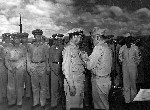 |
106k | Photo taken on 15 February 1943 as Admiral William Halsey pins the Navy Cross on Admiral Willis Augustus Lee for his leadership and victory during the Battle at Guadalcanal on 14-15 November 1942. The ceremony was held on the Washington (BB-56). | USN photo courtesy of Mike Green. | |
 |
105k | 15 February 1943 photo of Admiral Willis Augustus Lee speaking to the assembled Washington (BB-56) crew after being presented the Navy Cross. | USN photo courtesy of Mike Green. | |
 |
132k | Washington's (BB-56) crew assembled for comedian Joe E. Brown performing on the ship's fan tail on 15 February 1943 in Dumbea Bay, Noumea, New Caledonia. Performed the same day, after Halsey awarded the Navy Cross to RADM Lee. From wikipedia World War II In 1939, Brown testified before the House Immigration Committee in support of a bill that would allow 20,000 German-Jewish refugee children into the U.S. He later adopted two refugee children. At age 50 when the U.S. entered World War II, Brown was too old to enlist. Both of his biological sons served in the military during the war. In 1942, Captain Don E. Brown was killed when his Douglas A-20 Havoc crashed near Palm Springs, California. Even before the USO was organized, Brown spent a great deal of time traveling, at his own expense, to entertain troops in the South Pacific, including Guadalcanal, New Zealand, and Australia, as well as the Caribbean and Alaska. He was the first to tour in this way, before Bob Hope made similar journeys. Brown also spent many nights working and meeting servicemen at the Hollywood Canteen. He wrote of his experiences entertaining the troops in his book Your Kids and Mine. On his return to the U.S., Brown brought sacks of letters, making sure they were delivered by the Post Office. He gave shows in all weather conditions, many in hospitals, sometimes doing his entire show for a single dying soldier. He signed autographs for everyone. For his services to morale, Brown became one of only two civilians to be awarded the Bronze Star during World War II. |
Text & ID courtesy of Richard Averitt. USN photo courtesy of Mike Green. |
|
 |
415k | By the bay (possibly at Noumea), Washington (BB-56) & and an APA, possibly the Hunter Liggett (APA-14). One of the old 535-foot transports (built during the WWI program for general passenger liner use). Several of these became USN APA's in WWII. Washington departed Noumea on 30 April 1943, bound for the Hawaiian Islands. While en route, TF 16 joined up; and, together, the ships reached Pearl Harbor on 8 May. Washington, as a unit of, and as flagship for, TF 60, carried out battle practice in Hawaiian waters until 28 May 1943, after which time she put into the Pearl Harbor Navy Yard for overhaul. The photo has a caption on the back that says; " late 1943; off Solomon Islands." I don't think that this caption is true, as the MS22 hull camouflage scheme paint line is well below her anchor. This dates the photo to after April, 1944, as the Washington was so repainted when being repaired from her collision with the Indiana (BB-58). |
National Archives photo # 80-G-82243, courtesy of David Buell. Text courtesy of DANFS & Mike Green. Photo i.d. courtesy of Chuck Haberlein & Mike Green. |
|
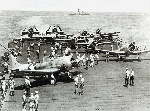 |
167k | Washington (BB-56) as seen on 2 May 1943 astern of the Enterprise (CV-6). The ships are part of TF 16 and are enroute to Pearl Harbor after leaving Noumea on 30 April 1943. TF 16 arrived at Pearl Harbor on 8 May. | USN photo courtesy of Mike Green. | |
 |
74k | Maneuvering off Oahu, Hawaii, in Mid-1943. Taken by a Yorktown (CV-10) photographer. | Official USN photo Naval History and Heritage Command # 80-G-K-15103, now in the collections of the National Archives. | |
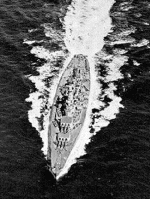 |
175k | Bow-on/overhead showing the ship at sea during 1943. | USN photo. | |
 |
326k | Washington (BB-56) after 7 August 1943. The ship in the picture has Mark 8 radars and Bofors. All installed at Pearl between May and July 27. First place she arrived afterwards was Havannah Harbor, Efate on 7 August. | Source; Her war diaries and PH Navy Yard diaries. Text & ID courtesy of Richard Averitt. USN photo courtesy of Pieter Bakels. |
|
 |
443k | Washington (BB-56) on 12 November, 1943 with unknown Essex class carrier, (Probably) Yorktown (CV-10) or Lexington (CV-16), steams towards the Gilbert Islands to take part in Operation Galvanic. | USN photo # 80-G-204897, now in the collection of the National Archives. Courtesy of Tracy White & improved by Pieter Bakels. | |
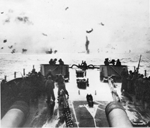 | 231k | A view of the action over the bow during the Gilbert Islands Operation. Note the bow 20mm guns and crew in ready position and also the carrier steaming ahead. December, 1943. | USN photo by Capt. Herbert Campbell, courtesy of Pieter Bakels. | |
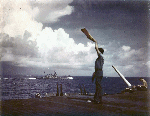 |
64k | Washington (BB-56) as seen from the Essex (CV-9) in 1944 as part of TF 58. Interesting features the photo include sailors on the flight deck, with one signaling another ship. Other items include deck edge guns; a 40mm quadruple gun mount and a single 5"/38 caliber gun mount A.A gun. An unidentified Independence class light carrier is seen on the far side of the Washington with other unidentified ships in the far distance. | USN photo courtesy of Mike Green. | |
 |
72k | Line art drawing of the Washington (BB-56), 1944. | Contributed by Joseph M. Radigan (of blessed memory). | |
 |
759k | Washington (BB-56) in Majuro Atoll, Kwajalein after ramming the Indiana (BB-58). | Photo courtesy of curator@battleshipnc.com website; Source: United States Navy, photo via Mike Green. | |
 |
89k | Alongside Vestal (AR-4) after collision with Indiana (BB-58) on 1 February 1944. | Naval History and Heritage Command # NH 68352. Contributed by Joseph M. Radigan (of blessed memory). | |
 |
83k | Washington (BB-56) underway with a collapsed bow, after colliding with Indiana (BB-58) during the Marshalls Operation, 1 February 1944. | U.S. Naval Historical Center Photograph # NH 68353. | |
 |
106k | Washington (BB-56) damage received in her 1 February 1944 collision with Indiana (BB-58). | U.S. Naval Historical Center Photograph # NH 68354. | |
 |
93k | Washington (BB-56) damage received in her 1 February 1944 collision with Indiana (BB-58) View looks inboard through the opening in the hull forward of the starboard bow. | U.S. Naval Historical Center Photograph # NH 68356. | |
 |
42k | The bow of the Washington (BB-56) after the collision with the Indiana (BB-58). The picture was taken at Majuro Lagoon on 2 February 1944. Only the anchor chains prevented the main deck from totally collapsing. | Naval History and Heritage Command # NH 68355. Contributed by Joseph M. Radigan (of blessed memory). | |
 |
26k | Photo taken 3 February 1944 at Majuro lagoon after her collision with the Indiana (BB-58) which occurred two days earlier. Due to the demolition of the bow, she was unable to drop anchors. She was lashed to the tanker Pecos (AO-65) with ten 10" hawsers. This photo also shows the repair ship Vestal (AR-4) whose divers inspected the ship's bottom, screws and rudders for damage and who also cut away part of the tangled mass of wreckage at the edge of the damaged area. This enabled the crews to shore up the ship's bulkheads and reduced the drag and stress on the hull for her trip to Pearl Harbor where a temporary bow was fitted. The ship's bow was permanently replaced when she arrived at Puget Sound Navy Yard. When the ship arrived at Puget Sound on 12 March 1944, her new bow was already fabricated and waiting for installation when the ship was dry-docked. | USN photo. | |
 |
698k | Washington (BB-56) dry-docked at Pearl Harbor Navy Yard on 19 February 1944 after colliding with the Indiana (BB-58) on 1st of February. The ship will receive a temporary bow before proceeding to Puget sound Navy Yard for a permanent repairs. | Source: United States National Archives, Photo No. ARC 512915 via Mike Green. | |
 |
1.46k | Washington (BB-56) at Pearl Harbor Navy Yard fitted with temporary bow on 4 March 1944. The dock is being flooded, as the Washington prepares to sail to Puget Sound Naval Shipyard, where the ship will be repaired, along with a refit and upgrades. | Source: United States National Archives, Photo No. ARC 512915 via Mike Green. | |
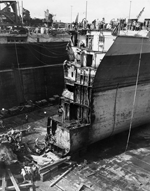 |
484k | Washington (BB-56) having her bow repaired after her collision with the Indiana (BB-58). | USN photo courtesy of Scott Koen & ussnewyork.com. Photo & text i.d. courtesy of Richard M. Jensen. | |
 |
101k | Washington (BB-56) in drydock at the Pearl Harbor Navy Yard while receiving temporary repairs, circa March 1944. | U.S. Naval Historical Center Photograph # NH 101174. | |
 |
33k | Photo from 13 March 1944 shows the Washington (BB-56) entering drydock #5 at Puget Sound Naval Shipyard at Bremerton, Wash. The false bow was fitted at Pearl Harbor. The ship was overhauled following the installation of the new bow. The ship was in drydock until 9 April 1944. | USN photo. | |
 |
792k | Off the Puget Sound Navy Yard, Washington, 26 April 1944, following repair of collision damage to her bow. | Photo # 19-N-63999 from the Bureau of Ships Collection in the U.S. National Archives, via Pieter Bakkels. Photo i.d. courtesy of Robert Hurst. | |
 |
451k | Starboard quarter view of the Washington (BB-56) off the Puget Sound Navy Yard, Washington, 26 April 1944. The ship had just completed a refit, along with a bow replacement, necessitated by a collision with the Indiana (BB-58). | Source: United States National Archives, Photo No. 19-N-64001 via Mike Green. | |
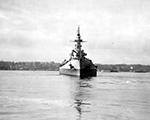 |
434k | Bow view of the Washington (BB-56) off the Puget Sound Navy Yard, Washington, 26 April 1944. The ship had just completed a refit, along with a bow replacement, necessitated by a collision with the Indiana (BB-58). | Source: United States National Archives, Photo No. 19-N-64003 via Mike Green. | |
 |
648k | She is in her final WW2 configuration and is seen cruising at 10 knots in the Straits of Juan de Fuca off Port Angeles, Washington on 29 April 1944. | BuAer photo #10736, courtesy of David Buell. | |
 |
152k | The Washington (BB-56) as seen from a port quarter overhead view. This is a good detail shot of the ship with her secondary armament, light A.A. armament and flight handling facilities easily visible. All 1.1"/75 quadruple mounts have been replaced and supplemented with fifteen 40mm quadruple mounts. The ship had just completed a refit and new bow installation at Puget Sound Navy Yard, necessitated by her collision with the Indiana (BB-58) on February 1st off Kwajalein Atoll. | Official USN photo courtesy of Mike Green. | |
 |
139k | Stern view of the Washington (BB-56) after her April, 1944 refit. | USN photo courtesy of Mike Green. | |
 |
759k | Side view of Washington (BB-56) while underway at sea in the Pacific, with a DD and CVE in company, c. 1944. | Source: United States National Archives, Photo No. 80-G-K-2184 via Mike Green. | |
 |
65k | A very impressive and rare line of fast battleships during the Marianas Operation, June 1944. Battleships are from front to rear: Washington (BB-56),North Carolina (BB-55), South Dakota (BB-57). Others involved were Indiana (BB-58), Alabama (BB-60), Iowa (BB-61), and New Jersey (BB-62). Here the ships are conducting AA practice to port. | USN photo. | |
 |
46k | Washington (BB-56) in company with the Hancock (CV-19) during flight operations. The "wet bow characteristics" of the is evident here even though the sea is moderate. High speed sailing, as inflight operations, meant water and spray over the bow. | USN photo. | |
 |
356k | Four Battleships of Task Group 58.7 in the fleet anchorage at Majuro Atoll in the Marshall Islands. It was taken on the 7/8/44. TG 58.7 had returned to Majuro on 27 June 1944, after taking part in operations in the Philippine Sea and bombarding Saipan and Tinian. The four Battleships are identifiable by their paint schemes: New Jersey (BB-62) and Iowa (BB-61) in the foreground, and Washington (BB-56) and North Carolina (BB-55) further back, surrounded by destroyers and other ships. The resolution of the photo is not that great, but the photo is of interest due to the number of Battleships in one frame. |
Photo i.d. & text research courtesy of Larry Reese. Official USN photo via Acme Newspictures, Inc. courtesy of David Buell. |
|
 |
86k | Washington (BB-56) in the Pacific Ocean. Photo taken late '44-early '45. | USN photo. | |
 |
346k | A Japanese Nakajima B6n Tenzan (AKA Jill by allied forces) torpedo bomber is seen being flamed by AA fire from the Washington (BB-56) and Essex (CV-9) on 14 October 1944. The plane tried to escape by passing astern of the Washington after an unsuccessful attack on the Essex. | Source: US Navy and Marine Corps Museum/Naval Aviation Museum, Photo No.1983.046.010.032 courtesy of Mike Green. | |
 | 361k | Maryland (BB-46), Colorado (BB-45) & Washington (BB-56), circa post November 1943. | USN photo courtesy of David Buell. | |
 |
78k | The light cruiser Santa Fe (CL-60) at sea during the Philippines campaign, 12 December 1944. Washington (BB-56) is alongside an oiler in the center background. Photographed from Essex (CV-9). | Official USN photo # 80-G-301357, now in the collections of the National Archives. | |
 |
570k | TG 38.3 beginning to reform a column formation after making a simultaneous turn to port. The ships are entering Ulithi Anchorage on 12 December 1944 after strikes against the Japanese in the Philippines. Ships visible in this photo are: Langley (CVL-27); Ticonderoga (CV-14); Washington (BB-56); North Carolina (BB-55); South Dakota (BB-57); Santa Fe (CL-60); Biloxi (CL-80); Mobile (CL-63) and Oakland (CL-95). | None of these can be 12 December. These ships (TG 38.3) departed Ulithi on 11 December. This TG entered Ulithi together on 2 and 24 December. These are likely 24 December 1944 when they're conducting numerous maneuvers and firing exercises while entering Ulithi. Slight chance 2 December but if Oakland (CL-95) is in the picture, she didn't enter with the others on 2 December. One thing for certain, these are not the 11th like the caption on NHHC states. Many open discussions on forums discussing the merits of both dates. Text & ID courtesy of Richard Averitt. USN photo courtesy of Pieter Bakels. |
|
 |
455k | TG 38.3 enters Ulithi anchorage in column, 12 December 1944 while returning from strikes on targets in the Philippines. Ships are (from front): Langley (CVL-27); Ticonderoga (CV-14); Washington (BB-56); North Carolina (BB-55); South Dakota (BB-57); Santa Fe (CL-60); Biloxi (CL-80); Mobile (CL-63) and Oakland (CL-95). | None of these can be 12 December. These ships (TG 38.3) departed Ulithi on 11 December. This TG entered Ulithi together on 2 and 24 December. These are likely 24 December 1944 when they're conducting numerous maneuvers and firing exercises while entering Ulithi. Slight chance 2 December but if Oakland (CL-95) is in the picture, she didn't enter with the others on 2 December. One thing for certain, these are not the 11th like the caption on NHHC states. Many open discussions on forums discussing the merits of both dates. Text & ID courtesy of Richard Averitt. Official USN photo # 80-G-301351 & HN-SD-97-00850 now in the collections of the National Archives. Photo from the Department of Defense Still Media Collection, courtesy of dodmedia.osd.mil. | |
 | 1.20k | TG 38.3 enters Ulithi anchorage in column, 12 December 1944 while returning from strikes on targets in the Philippines. Ships are (from front): Ticonderoga (CV-14); Washington (BB-56); North Carolina (BB-55); South Dakota (BB-57); Santa Fe (CL-60). | None of these can be 12 December. These ships (TG 38.3) departed Ulithi on 11 December. This TG entered Ulithi together on 2 and 24 December. These are likely 24 December 1944 when they're conducting numerous maneuvers and firing exercises while entering Ulithi. Slight chance 2 December but if Oakland (CL-95) is in the picture, she didn't enter with the others on 2 December. One thing for certain, these are not the 11th like the caption on NHHC states. Many open discussions on forums discussing the merits of both dates. Text & ID courtesy of Richard Averitt. USN photo courtesy of Pieter Bakels. |
|
 |
575k | TG 38.3 entering Ulithi on 12 December 1944, taken by Essex (CV-9), & showing the Ticonderoga (CV-14); Washington (BB-56); North Carolina (BB-55); and South Dakota (BB-57). | Text & ID courtesy of Richard Averitt. None of these can be 12 December. These ships (TG 38.3) departed Ulithi on 11 December. This TG entered Ulithi together on 2 and 24 December. These are likely 24 December 1944 when they're conducting numerous maneuvers and firing exercises while entering Ulithi. Slight chance 2 December but if Oakland (CL-95) is in the picture, she didn't enter with the others on 2 December. One thing for certain, these are not the 11th like the caption on NHHC states. Many open discussions on forums discussing the merits of both dates. Text & ID courtesy of Richard Averitt. USN photo courtesy of Pieter Bakels. |
|
 |
88k | Battleships of the U.S Pacific Fleet following Ticonderoga (CV-14) [out of photo ahead of the Washington (BB-56)] entering Ulithi Atoll on 12 December 1944. Washington, North Carolina (BB-55), and South Dakota (BB-57) are in line ahead formation. Note that three camouflage schemes are shown; MS22 (Washington ), MS32/18d (North Carolina ) and MS21 (South Dakota ). | None of these can be 12 December. These ships (TG 38.3) departed Ulithi on 11 December. This TG entered Ulithi together on 2 and 24 December. These are likely 24 December 1944 when they're conducting numerous maneuvers and firing exercises while entering Ulithi. Slight chance 2 December but if Oakland (CL-95) is in the picture, she didn't enter with the others on 2 December. One thing for certain, these are not the 11th like the caption on NHHC states. Many open discussions on forums discussing the merits of both dates. Text & ID courtesy of Richard Averitt. Naval Historical Photo # 80-G-301950 submitted by Mike Green. |
|
 |
321k | As seen from the Essex (CV-9), the Langley (CVL-27) with the Washington (BB-56) astern plowing through heavy seas on 13 January 1945 in the South China Sea. The stability differences of light carriers versus battleships is clearly evident. | Photo courtesy of US Navy and Marine Corps Museum/Naval Aviation Museum, Photo No. 1983.046.010.098 via Mike Green. | |
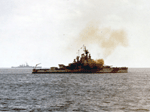 | 59k | Nevada (BB-36) bombarding Iwo Jima, 19 February 1945. A North Carolina class battleship, probably Washington (BB-56) is in the left distance. Note: The ship in the background is the Washington, as this ship doesn't have the secondary conn that the North Carolina (BB-55) had added on the tower foremast. | Official USN photo # 80-G-K-3510, now in the collections of the National Archives. Photo i.d. & partial text courtesy of Mike Green. | |
 |
1.69k | Two U.S. Navy Curtiss SB2C-4 Helldiver dive bombers of Bombing Squadron 83 (VB-83) fly against the backdrop of ships of Task Group 38.3 operating off Okinawa. VB-83 operated from Essex (CV-9), pictured in foreground, during the period March-September 1945. Note the geometric identification symbols ("G-symbols") of the aircraft from the Essex. In the background are the battleship Washington (BB-56), a long-hull Essex-class carrier and an Independence-class light carrier. | Photo courtesy of US Navy and Marine Corps Museum/Naval Aviation Museum, Photo No. 1996.253.360 via Robert Hurst. | |
 |
131k | Washington (BB-56) with fleet oiler Kaskaskia (AO-27) off Okinawa, April 1945. | USN photo courtesy of Jerry Mason & Mike Green. | |
 |
205k | Washington (BB-56) clearing the T3-S2-A1 tanker Kaskaskia (AO-27) off Okinawa, April 1945. | USN photo courtesy of Pieter Bakels. | |
 |
61k | The Washington (BB-56) after May, 1944. The MS22 camouflage scheme was improperly applied when her bow was replaced, as it wasn't parallel to the waterline at the bow. 5"/38 mount barrels pointing upwards indicate refueling approaching or just completed. The condition of the hull paint indicates a need for repainting which further indicates Okinawa operations. This photo is in the book "Closing the Circle" by Edwin B. Hoyt and this book describes Naval Operation at the end of the WW2. "If" this photo in Hoyt's book is correct then it an April, 1945 photo of the ship. The Washington left for her final refit in April/May, 1945. |
USN photograph courtesy of David Buell. Text courtesy of Mike Green. |
|
| Post WW-II - Scrapping |
||||
 |
431k | Washington (BB-56) anchored off Puget Sound, Navy Yard, 10 September 1945 after completing her final refit. When she completed her post-repair trials and conducted underway training out of San Pedro, Calif., she headed for the Panama Canal, returning to, the Atlantic Ocean. Joining TG 11.6 on 6 October 1945. | Source: United States National Archives, Photo No. 19-N-89067 via Mike Green. | |
 |
265k | Running post-overhaul trials in Puget Sound, Washington, on 10 September 1945. | USN photo courtesy of Pieter Bakels. | |
 |
120k | Washington (BB-56) on post refit trials on 10 September 1945. | USN photo. | |
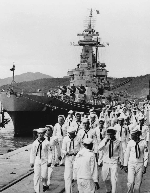 |
78k | Washington's (BB-56) crew on shore leave while the ship is docked in Balboa Inner Harbor, prior to transiting the Panama Canal in October 1945. | USN photo courtesy of Pieter Bakels. Text & photo i.d. courtesy of Mike Green. | |
 |
158k | US battleship making passage through section of Panama Canal as most of crew stand above decks, canal pulley trains visible on both sides of lock on 11 October 1945. This is the battleship Washington (BB-56). I base this identification on the SK air search radar [the North Carolina (BB-55) was fitted with the oval shaped SK-2], the fact that there are only 5 port holes at the front of the bridge [North Carolina was equipped with 8] and the fact that there is no secondary conning level on the tower foremast, which was mounted on North Carolina, but never mounted on the Washington . |
Text & ID courtesy of Richard Averitt. Photographer: Thomas D. Mcavoy, courtesy of life.time.com Photo i.d. courtesy of Mike Green. | |
 |
122k | Washington (BB-56) and Enterprise (CV-6) transiting the Panama Canal from the Pacific to the Atlantic, 11 October 1945. They were then en route to New York to participate in Navy Day celebrations. | Text & ID courtesy of Richard Averitt. Official USN photo Naval History and Heritage Command # 80-G-K-6568 now in the collections of the National Archives. |
|
 |
97k | Washington (BB-56) and Enterprise (CV-6) in the Miraflores Locks, Panama Canal, 11 October 1945. Night Air Group 55 planes are on the Big E's flight deck. A US Navy blimp is overhead. | Photo & text courtesy of William T. Barr via Joel Shepherd & cv6.org, submitted by Mike Green. | |
 |
2.60k | Enterprise (CV-6) (foreground), Washington (BB-56) (behind Big E) and North Carolina (BB-55) (only stack tops visible), docked in Balboa Inner Harbor, prior to transiting the Panama Canal, October 1945. | Photo & text courtesy of Arnold W. Olson via Joel Shepherd & cv6.org, submitted by Mike Green. | |
 |
174k | 12 October 1945 photo of the ship leaving the Panama Canal for what was her last transit through the Canal. | USN photo. | |
 |
116k | Washington (BB-56) entering Philadelphia on October, 1945 to celebrate Navy Day at her birthplace. The close up shot shows good detail of her A.A. batteries, radars and general ship layout in her final wartime appearance. | USN photo. | |
 |
149k | Washington (BB-56) entering Philadelphia on October, 1945 to celebrate Navy Day at her birthplace. The close up shot shows good detail of her A.A. batteries, radars and general ship layout in her final wartime appearance. | USN photo. | |
 |
789k | BATTLEWAGON IN WITH STORM TOSSED GI'S. THE BATTLESHIP WASHINGTON (BB-56) IS SHOWN AS SHE ARRIVED IN NEW YORK THIS MORNING WITH HUNDREDS OF SERVICEMEN FROM THE EUROPEAN THEATRE JUST GETTING UNDER THE WIRE TO PERMIT THE WARRIORS TO SPEND CHRISTMAS IN THE UNITED STATES. THE HAPPY GI'S LINE THE RAIL OF THE BATTLEWAGON WHICH TOOK A POUNDING FROM A 75 MILE AN HOUR GALE DURING THE CROSSING. |
International News Photo courtesy of Pieter Bakkels. | |
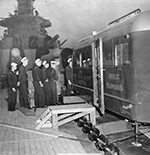 |
556k | "Telephone service for Washington (BB-56) crew", 19 October 1945. "Sailors line up to take their turns at the telephone booths in a trailer placed on the forecastle of the giant battleship yesterday." |
Photo courtesy of the George D. McDowell Philadelphia Evening Bulletin Photographs @ digital.library.temple.edu | |
 |
93k | Sailors aboard the Washington (BB-56), ca. 27 October 1945. | Accession number: 70-4033 courtesy of trumanlibrary.org | |
 |
431k | Taken in 1946 and appears to be taken when the Washington (BB-56) and North Carolina (BB-55) were used as host ships for the midshipman's cruises in the middle to late summer. The two North Carolina's were kept active longer than the South Dakota's due to their better crew quarters and living conditions. The distinctive funnel caps and the properly applied MS 22 camouflage scheme (April, 1944 scheme was improperly applied with the blue/gray hull border being below the anchor and not parallel to the sea at the main decks lowest point/ this was corrected in June-through September, 1945 refit). It looks like all of the deck mounted 40mm mounts have been removed except for those mounted next to #3 main turret and those on the extreme stern. There are 11 mounts total, where she used to carry 15 mounts. The boat handling cranes are easily seen at her aft superstructure and unlike some of her fast battleship sister and cousins, she was scrapped with these still mounted. Two "SEAHAWK" spotting planes are stores at the stern catapults. She also retained her catapult structures too, unlike some of the other fast battleships. |
USN photo courtesy of David Buell. Partial text courtesy of Mike Green. | |
 |
72k | The Washington (BB-56) and North Carolina (BB-55) operating together after WW-II. | Courtesy of Mike Green. | |
 |
82k | Washington (BB-56) scoresheet on the conning tower. | USN photo. | |
 |
1.91k | 17 October 1945:WASHINGTON (BB-56) BACK FROM PACIFIC | A .P. Wirephoto courtesy of Pieter Bakkels. | |
 |
2.00k | LINE RAIL OF THE WASHINGTON (BB-56), 9 August 1946. Midshipmen from the U.S. Naval Academy..... |
A .P. Wirephoto courtesy of Pieter Bakkels. | |
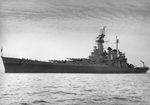 |
1.40k | Washington (BB-56) off Annapolis on 4-10-1946. | Photo by Alex Malashuk, Sun Newspapers, courtesy of Pieter Bakkels. | |
 |
118k | New York, 19 June--BATTLESHIP HEADS FOR DECOMMISSIONING--Tugboats move the Washington (BB-56) across the Hudson River today from the Brooklyn Navy Yard toward the Bayonne N.J. Supply Depot where the battleship will be decommissioned. The veteran of action in the Atlantic and Pacific will join the "operation mothball" fleet of about 2,000 Navy ships to be placed in reserve status with guns and engines greased and webbed, ready for any emergency. | A .P. Wirephoto courtesy of Mike Green. | |
 |
131k | 19 June 1947 as the ship was moved from the Brooklyn Navy Yard to the reserve ship facility at Bayonne, New Jersey. She was formally decommissioned on 27 June 1947 at 1500 hours. Along with the North Carolina (BB-55), Enterprise (CV-6), Franklin (CV-13) and Wasp (CV-18), she spent her final years until stricken and finally scrapped in 1961-62 at Kearney, New Jersey. | USN photo. | |
 |
517k | The Washington (BB-56) in mothballs (in the background). | Photo courtesy of Ron Reeves (of blessed memory) via Terrence G. Popravak, Jr. and Richard M. Jensen. | |
 |
210k | Bow view of the North Carolina (BB-55) & Washington (BB-56) in reserve at Bayonne, New Jersey on 2 February 1950. | Photographer: Herbert Gehr, courtesy of life.time.com | |
 |
37k | North Carolina (BB-55) & Washington (BB-56) in reserve at Bayonne, New Jersey on 25 February 1951. Note the weathered and peeling paint work as well as the light metal "igloos" covering the ships light AA weapons (Treasure Island Museum-SFCB). | Photo courtesy of Warship Boneyards, by Kit and Carolyn Bonner & submitted by Robert Hurst. | |
 | 112k | Bayonne Naval Supply Depot, New Jersey. Photographed on 15 April 1953 with ships in reserve. The two large ships at right on the near side of the peninsula are Alaska (CB-1) and Guam (CB-2). The next two ships astern are North Carolina (BB-55) and Washington (BB-56). Further astern are (from outboard to inboard) Fargo (CL-106), Albemarle (AV-5) and Wakefield (AP-21). The carriers Enterprise (CV-6) and Franklin (CV-13) are at the far left. Also present are the escort carriers Card (CVE-11), Croatan (CVE-25), Mission Bay (CVE-59), and Guadalcanal (CVE-60) along with the cruisers Providence (CL-82), Little Rock (CL-92), Spokane (CLAA-120) and Fresno (CLAA-121). One of the two CLAAs is tied up outboard of the Alaskas'. | Official USN photo Naval History and Heritage Command # 80-G-480262, now in the collections of the National Archives. | |
 |
142k | Bow views of the Washington (BB-56) (on right) and the Large Cruiser Alaska (CB-1) in June 1961 as they lie in the scrapping berths in Newark, New Jersey. | USN photo courtesy of David Buell. | |
 |
85k | Stern view of the Washington (BB-56) (on left) and the Large Cruiser Alaska (CB-1) in June 1961. | USN photo courtesy of David Buell. | |
 |
98k | Amidships view of the scrapping of the Washington (BB-56) (on left) and the Alaska (CB-1) in June 1961. | USN photo courtesy of David Buell. | |
 |
1.63k | Washington (BB-56) items were contributed to the State of Washington and were placed on display in the foyer of the Legislative Building in 1962. Items on display were the port and starboard running lights, throttle wheels, inclinometers, 5" and 16" gun tampions, a photo of Washington, the ship's bell, and the ship's wheel. The picture shows then-Governor Albert Rosellini unveiling the display with Navy personnel in 1962. | Rosellini with Washington display, 1962, photographer unknown, State Governors' Negative Collection, 1945-1975, Washington State Archives, Digital Archives courtesy of Bryan D. Fisher, RMC, USCG. | |
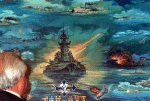 | 376k | A guest studies a painting depicting the history of battleships. The artwork was painted by George Skybeck and presented to the Pearl Harbor Survivors Association during their annual banquet at Honolulu, Hawaii, on 8 December 1991. | USN photo # DN-SC-92-05391, by PHC Carolyn Harris, from the Department of Defense Still Media Collection, courtesy of dodmedia.osd.mil. | |
 | 371k | A quote made by Fleet Adm. Chester W. Nimitz is inscribed on a granite wall at the National World War II Memorial located on the National Mall in Washington, D.C. Fleet Adm. Nimitz was the United States signatory to the surrender terms aboard the battleship Missouri (BB-63) in Tokyo Bay, Japan on 2 September 1945, thus ending World War II. Established by the American Battle Monuments Commission, the memorial honors all military veterans of World War II, the citizens on the home front, the nation at large, and the high moral purpose and idealism that motivated the nation's call to arms. On 29 May 2004, the memorial was formally dedicated with an estimated 200,000 people expected to attend, and includes 100,000 visiting veterans of all wars. | USN photo # N-0295M-011 by Photographer's Mate 2nd Class Daniel J. McLain, courtesy of news.navy.mil. | |
 |
83k | The Washington's (BB-56) bell located at the new Naval Museum at the Naval Shipyard in Bremerton, Wa. | Photo courtesy of Larry Lee RM1/USN Ret. | |
| Commanding Officers | ||
| 01 | CAPT. Benson, Howard Hartwell James, USN (USNA 1909) :COMO | 15.05.1941 - 25.07.1942 |
| 02 | CAPT. Davis Sr., Glenn Benson, USN (USNA 1913) :VADM | 25.07.1942 - 27.04.1943 |
| 03 | CAPT. Maher, James Edward, USN (USNA 1915) :VADM | 27.04.1943 - 23.04.1944 |
| 04 | CAPT. Cooley Jr., Thomas Ross, USN (USNA 1917) :RADM | 23.04.1944 - 16.11.1944 |
| 05 | CAPT. Good, Roscoe Fletcher, USN (USNA 1920) :ADM | 16.11.1944 - 05.06.1945 |
| 06 | CAPT. McInerney, Francis Xavier, USN (USNA 1921A) :VADM | 05.06.1945 - 00.07.1946 |
| 07 | CAPT. Eccles, Henry Effingham, USN (USNA 1922) :RADM | 00.07.1946 - 02.04.1947 |
| 08 | CDR. Wright Jr., Archie Taylor, USN (USNA 1933) | 02.04.1947 - 27.06.1947 |
The contact listed, Was the contact at the time for this ship when located. If another person now is the contact, E-mail me and I will update this entry. These contacts are compiled from various sources over a long period of time and may or may not be correct. Every effort has been made to list the newest contact if more than one contact was found.
| Back To The Main Photo Index | Back To The Battleship Photo Index Page |